Strength Through Joy
Strength Through Joy (KdF) was established as a subsidiary of the German Labour Front on 27th November, 1933. It was an attempt to organize workers' leisure time rather than allow them to organize it for themselves, and therefore enable leisure to serve the interests of the government. Robert Ley claimed that "workers were to gain strength for their work by experiencing joy in their leisure". (1) The scheme has been described as "regimented leisure" and that Hitler deemed it "necessary to control not only the working hours but the leisure hours of the individual". (2)
The scheme had been heavily influenced by the theories of the Belgian fascist, Henri de Man, who sought to fuse the theories of Karl Marx and Sigmund Freud. It also took some of the ideas behind the Italian Fascist Opera Nazionale Dopolavoro, the leisure and recreational organization, concentrating on sports and other outings for adults, that had been introduced by Benito Mussolini in 1925. (3)
Albert Speer was a great supporter of Ley's plan to persuade factory owners to improve the workplace: "First we persuaded factory owners to modernize their offices and to have some flowers about. But we did not stop there. Lawn was to take the place of asphalt. What had been wasteland was to be turned into little parks where the workers could sit during breaks. We urged that window areas within factories be enlarged and workers' canteen set up... We provided educational movies and a counseling service to help businessmen on questions of illumination and ventilation... One and all devoted themselves to the cause of making some improvements in the workers' living conditions and moving closer to the ideal of a classless People's Community." (4)
Sport and Cultural Activities
Since the late 19th century the Social Democrat Party (SDP) and the German trade unions had built sports grounds and hiking hostels. These were now taken over by the German Labour Front and used for its members. With these resources it was able to offer discounted leisure activities that were within the financial reach of many workers and their families. By 1934-35, over three million people were taking part in its physical education and gymnastics evenings, while many others took advantage of the cheap coaching it offered in tennis, golf, skiing, sailing and other upper-middle-class-sports. (5)
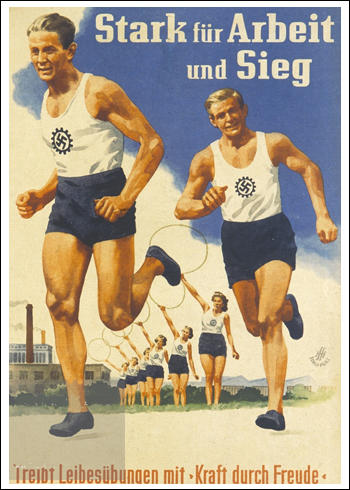
Strength Through Joy promoted evening classes, amateur cultural activities, recitals and travelling art exhibitions. Plays were performed in factories and specially organized KdF concerts, featuring important classical conductors and soloists, such as Carl Bohm, Eugen Jochum and Wilhelm Furtwanger, played to German workers. (6) The KdF had its own ninety-piece symphony orchestra which continually toured the country and in 1938 over two and a half million people attended its concerts. One observer pointed out that the KdF "made available at bargain rates tickets to the theatre, the opera and concerts, thus making available more highbrow entertainment to the labouring man." (7)
The success of the KdF brought Ley into conflict with Joseph Goebbels. According to his biographer, Toby Thacker, Goebbels objected to the idea that the professional associations of German artists should be part of the Labour Front. (8) Goebbels held a meeting with Adolf Hitler and eventually he agreed that he should be free to organize all persons "belonging to the areas of activity under his jurisdiction". (9)
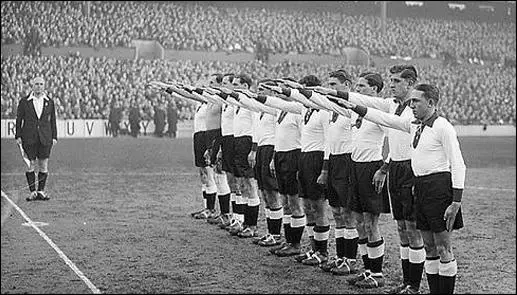
In December 1935, Strength Through Joy arranged for 10,000 Germans to travel to London to watch their team play England at White Hart Lane. It was a curious choice of venue because within football Spurs are known as “the Jewish club” owing to support from Jewish communities in north London. There were also Jews among the players. On the day of the match a demonstration march converged on White Hart Lane. Leaflets printed in German were handed out by demonstrators and there were some minor scuffles with pro-Nazi sympathisers. Before the game the German players gave the nazi salute and the swastika was flown over the ground. England won the game 3-0. (10)
Subsidized Holidays
The most popular aspect of Strength Through Joy was the provision of subsidized holidays. Large sections of the labour force were for the first time given the opportunity of holidaying away from home. The holidays ranged in price from a week in the Harz Mountains (28 marks), one week at the North Sea coast (35 marks) and a fortnight at Lake Constance (65 marks). As the average wage of an industrial worker was about 30 marks, it enabled a third of all workers to go on holiday. (11)
The KdF set about building its own model resort on the Baltic island of Rügen. Construction began under the supervision of Albert Speer on 3rd May 1936. "The resort spanned eight kilometres of the Baltic shore, with six-story residence blocks interspersed with refectories and centred on a huge communal hall designed to accommodate all 20,000 of the resort's holidaymakers as they engaged in collective demonstration of enthusiasm for the regime and its policies. It was consciously designed for families, to make good the lack of facilities for them in other Strength Through Joy enterprises, and it was intended to be cheap enough for the ordinary worker to afford, at a price of no more than 20 Reichsmarks for a week's stay." (12)
The better paid workers were able to go abroad. A tour of Italy cost 155 marks. Strength Through Joy commissioned the building of two 25,000-ton purpose-built ships and chartered ten others to handle ocean cruises. The Robert Ley could carry 1,600 passengers. It only had forty lavatories and 100 showers but 156 loudspeakers that relayed on-board propaganda. (13) The liner also included a gymnasium, a theatre and a swimming pool to ensure that participants engaged in regular healthy exercise and experienced serious cultural events. (14)
These cruise liners sailed as far as the Norwegian fjords, Madeira, Libya, Finland, Bulgaria and Turkey. 180,000 Germans went on cruises in 1938 and the volume of tourism doubled. (15) In 1939 alone, 175,000 people went to Italy on organized trips, a good number of them travelling on cruise liners. (16)
William L. Shirer, an American journalist went on a KdF cruise: "Though life abroad was organized by Nazi leaders to a point of excruciation, the German workers seemed to have a good time. And at bargain rates! A cruise to Maderia, for instance, cost only $25, including rail fare to and from the German port, and other jaunts were equally inexpensive... In winter special skiing excursions to the Bavarian Alps were organized at a cost of $11 a week, including car fare, room and board, rental of skis and lessons from a ski instructor." (17)
The governments of other European countries took an interest in what the KdF was doing. The British ambassador in Berlin, Sir Neville Henderson, pointed out: "There are, in fact, many things in the Nazi organization and ideology, which we might study and adapt to our own use with great profit both to the health and happiness of our own nation and old democracy." (18)
Volkswagen
While in prison in Adolf Hitler read a lot of books. Most of these dealt with German history and political philosophy. Later he was to describe his spell in prison as a "free education at the state's expense." One writer who influenced Hitler while in prison was Henry Ford's autobiography, My Life and Work (1922). It had been translated into German by Curt and Marguerite Thesing. It was one of a small collection of books that was found in his office after his death at Nazi headquarters. (19)
Hitler also read an article entitled the Motorization of Germany. It was during this time that Hitler developed the idea that he wanted to be responsible for Germany's Model T. According to Richard Evans, the author of The Third Reich in Power (2005), "by the early 1930s he was drawing rough sketches of a small family vehicle that would sell for less than a thousand Reichsmarks and so be within reach of the vast majority of the population". (20)
Soon after he gained power in 1933 Adolf Hitler announced that the "salvation of the German worker in an enormous and all-embracing attack on unemployment". (21) At the time six million people were registered as unemployed and three million more had disappeared from the employment statistics altogether, many of them women. In 1929 over 20 million had been in work, by the time Hitler took office, that number had fallen to 11.5 million. (22)
Hitler was aware that it was vital to reduce the number of people unemployed if he was to retain power. One of his first decisions was to order the construction of new highways under the direction of Fritz Todt. His goal was a network of 7,300 miles of four-lane highways. Todt calculated that building the motorways would provide employment for 600,000. By June 1935 there were over 125,000 men working on motorway construction. Hitler announced that this road building achievement was "an overture to peace" but was also undertaken to permit the rapid movement of troops in war. Hitler was especially interested in east-west highways in order to meet the demands of a two-front war. (23)
Hitler also wanted to fill these highways with German built motor cars. At that time, there was only one motor-car for every fifty persons (compared to one for every five in America). German people had to use a bicycle or public transportation to get about. Hitler approached leading figures in private industry and demanded they produced an automobile for around $396 (this was the kind of price being paid for cheap cars in America). They said it was impossible and so Hitler decided that they had to be produced by the state. (24)
In 1935 Adolf Hitler announced that the government had plans to produce a "People's Car" (Volkswagen). Hitler gave his drawings of his "beetle car" to Ferdinand Porsche, a man who had become famous for designing racing cars. However, Porsche's prototype design was not ready until the end of 1937. (25)
At Hitler's insistence, the car's production was funded by the German Labour Front as part of its Strength Through Joy scheme. Robert Ley, the movement's leader, was forced to provide 50 million marks in capital to produce the car. On 2nd August, 1938, Ley announced that: "A Volkswagen for every German - let that be our aim. That is what we want to achieve." He also gave details of how workers could obtain this new car. "I herewith proclaim the conditions under which every working person, can acquire an automobile. (i) Each German, without distinction of class, profession, or property can become the purchaser of a Volkswagen. (ii) The minimum weekly payment, insurance included, will be 5 marks. Regular payment of this amount will guarantee, after a period which is yet to be determined, the acquisition of a Volkswagen. The precise period will be determined upon the beginning of production." (26)
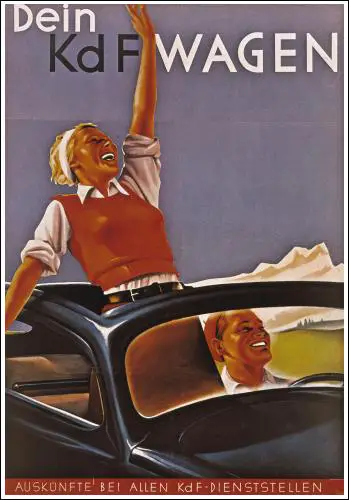
In contrast to universal hire-purchase practice, the scheme provided for delivery only after payment of the last installment. William L. Shirer, the author of The Rise and Fall of Nazi Germany (1959) wrote: "Dr Ley's ingenious plan was that the workers themselves should furnish the capital by means of what became known as a 'pay-before-you-get-it' installment plan - five marks a week, or if a worker thought he could afford it, ten or fifteen marks a week. When 750 marks had been paid in, the buyer received an order number entitling him to a car as it could be turned out." (27)
A huge advertising campaign was launched to persuade workers to put aside part of their wages to save up for one, with the slogan "a car for everyone". This was a great success and over 330,000 workers applied to buy a Volkswagen car. In 1938 a factory was built at Fallersleben to produce it. (28)
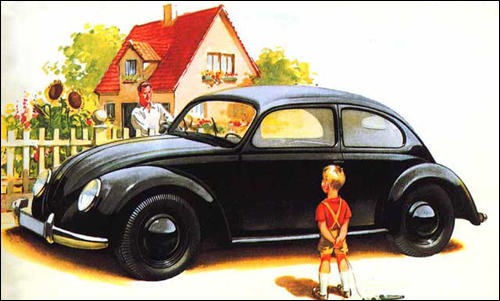
One German reported: "For a large number of Germans, the announcement of the People's Car is a great and happy surprise.... For a long time the car was a main topic of conversation in all sections of the population in Germany. All other pressing problems, whether of domestic or foreign policy, were pushed into the background for a while. The grey German everyday sank beneath notice under the impression of this music of the future. Wherever the test models of the new Strength-Through-Joy construction are seen in Germany, crowds gather around them. The politician who promises a car for everyone is the man of the masses if the masses believe his promises. And as far as the Strength-Through-Joy car is concerned, the German people do believe in Hitler's promises." (29)
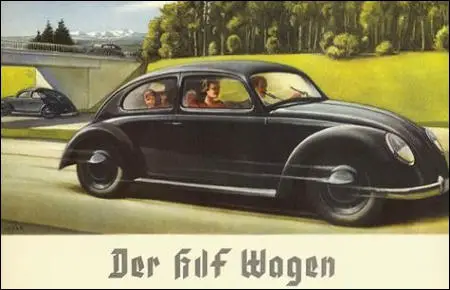
The first completed Volkswagen cars were exhibited at Munich and Vienna at the height of the Sudetenland Crisis in October 1938. (30) Another one was presented to Adolf Hitler at the International Motor Show in Berlin on 17th February 1939. Hitler gave it to his girlfriend Eva Braun as a birthday present. It became known as the "beetle" from the rounded shape Hitler gave it in his original design. (31)
Soon afterwards the Volkswagen factory at Fallersleben stopped making cars. Instead it turned to the manufacture of goods that would be needed by the military in the soon to start Second World War. Not a single car was produced for those 330,000 workers who had paid in their money to the German Labour Front. (32)
During the war the Volkswagen factory produced the Kübelwagen and the amphibious Schwimmwagen. Some of the labour force came from the Arbeitsdorf Camp. The company later admitted that it used 15,000 slaves during the war effort. German historians has estimated that 80% of Volkswagen's wartime workforce were supplied by concentration camps. (33)
Primary Sources
(1) Strength Through Joy statement (2nd August, 1938)
As of August 1 (1938), the great savings programme for the People's Car 'Strength-Through-Joy' will begin. I herewith proclaim the conditions under which every working person, can acquire an automobile.
(1) Each German, without distinction of class, profession, or property can become the purchaser of a Volkswagen.
(2) The minimum weekly payment, insurance included, will be 5 marks. Regular payment of this amount will guarantee, after a period which is yet to be determined, the acquisition of a Volkswagen. The precise period will be determined upon the beginning of production.
(3) Application for the Volkswagen savings programme can be made at any office of the German Labour Front and of 'Strength Through Joy', where further details can also be obtained. Factories and shops can submit collective orders.
A Volkswagen for every German - let that be our aim. That is what we want to achieve. Will all of you help in that; it shall be our way of saying 'thank you' to the Fuhrer.
Student Activities
Adolf Hitler's Early Life (Answer Commentary)
The Assassination of Reinhard Heydrich (Answer Commentary)
Heinrich Himmler and the SS (Answer Commentary)
The Last Days of Adolf Hitler (Answer Commentary)
Trade Unions in Nazi Germany (Answer Commentary)
Adolf Hitler v John Heartfield (Answer Commentary)
Hitler's Volkswagen (The People's Car) (Answer Commentary)
Women in Nazi Germany (Answer Commentary)
German League of Girls (Answer Commentary)
Kristallnacht (Answer Commentary)
The Political Development of Sophie Scholl (Answer Commentary)
The White Rose Anti-Nazi Group (Answer Commentary)
The Hitler Youth (Answer Commentary)
Night of the Long Knives (Answer Commentary)
British Newspapers and Adolf Hitler (Answer Commentary)
An Assessment of the Nazi-Soviet Pact (Answer Commentary)
Lord Rothermere, Daily Mail and Adolf Hitler (Answer Commentary)
Adolf Hitler and the Beer Hall Putsch (Answer Commentary)
Adolf Hitler and the First World War (Answer Commentary)
Adolf Hitler and the German Workers' Party (Answer Commentary)
Adolf Hitler the Orator (Answer Commentary)
Sturmabteilung (SA) (Answer Commentary)
Who Set Fire to the Reichstag? (Answer Commentary)
Appeasement (Answer Commentary)
